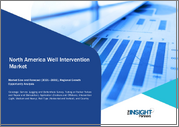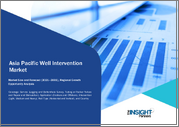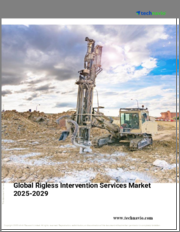
|
시장보고서
상품코드
1462661
갱정 개재 시장 예측(-2030년) : 제품, 서비스, 개입 유형, 갱정 유형, 용도, 지역별 세계 분석Well Intervention Market Forecasts to 2030 - Global Analysis By Product, Service, Intervention Type, Well Type, Application and by Geography |
||||||
세계의 갱정 개재 시장 규모는 2023년에 85억 7,000만 달러를 차지하며, 예측 기간 중 CAGR 6.2%로 성장하며, 2030년에는 130억 6,000만 달러에 달할 것으로 예상되고 있습니다. 갱정작업이란 석유 및 가스 갱정의 증산 및 생산량 회복을 목적으로 한 작업을 가리킵니다.
유정 시추에서 폐정에 이르기까지 이러한 개입은 유정 수명주기에 필수적인 작업입니다. 이러한 작업에는 시추, 자극, 청소, 유지보수 등 다양한 작업이 포함됩니다. 장애물, 생산량 감소, 장비 고장 등 유정이 직면한 구체적인 문제에 따라 어떤 갱정 개재 전략을 사용해야 하는지가 결정됩니다.
국제시추업체협회(IADC)에 따르면 유정에 대한 개입은 석유 및 가스정 운영 수명 동안 유정의 무결성과 생산성을 유지하는 데 필수적인 측면입니다.
에너지 소비량 증가
세계 인구 증가와 경제 성장으로 인해 제조, 운송, 주거용 등 많은 산업에서 에너지 수요가 증가하고 있습니다. 이러한 추세는 산업화와 도시화가 빠르게 진행되고 있는 개발도상국에서 특히 두드러집니다. 따라서 석유 및 가스 생산에 대한 수요가 증가함에 따라 탐사 및 개발에 대한 노력도 활발해지고 있습니다. 또한 증가하는 세계 인구의 에너지 수요를 충족하고, 생산률을 최적화하며, 현재 가동 중인 유정의 효율적인 운영을 보장하기 위해서는 갱정 개재 서비스가 필수적입니다.
규제 및 환경적 장벽
갱정 개재 활동은 환경 인식 증가와 강화된 규제 프레임워크에 의해 큰 제약을 받고 있습니다. 폐기물 관리, 배출물 관리, 섬세한 생태계 보전 등과 관련된 환경 규제를 준수하는 것은 작업의 복잡성과 비용을 증가시킵니다. 또한 규제 당국의 승인 및 인허가 절차로 인한 행정적 장애와 지연은 프로젝트의 적시성과 비용 효율성에 영향을 미칠 수 있습니다. 사업자는 벌금이나 비난을 피하기 위해 이러한 제한을 신중하게 협상하고 개입 활동이 환경에 미치는 영향을 최소화하고 법적 요건을 준수하는 방식으로 수행되도록 해야 합니다.
석유증진회수(EOR)법
EOR(Enhanced Oil Recovery) 방법의 도입은 기존 저류층에서 탄화수소 추출을 강화하고 유전의 수명을 연장할 수 있는 유망한 전망을 제시합니다. 화학적 플러딩, 석유 및 가스 압입, 열법 등 EOR 기술을 도입하여 청소 효율을 높이고 잔여 매장량을 대체하기 위해서는 신중한 개입이 필요합니다. 또한 운영자는 저류층 자극, 물 차단 및 적합성 제어와 같은 개입 기술을 활용하여 석유 생산량을 극대화하고 이전에 비경제적이라고 생각했던 매장량을 더 많이 발굴하여 EOR 프로세스의 효율성을 향상시킬 수 있습니다.
시장의 불확실성과 가격 변동성
갱정 개재 프로젝트는 석유 및 가스 시장의 가격 변동으로 인해 심각한 위협을 받고 있으며, 이는 사업자의 예산, 투자 선택 및 프로젝트의 경제성에 영향을 미치고 있습니다. 유가 변동은 매출의 불확실성, 비용 상승, 수익성 저하를 유발하여 사업자의 개입 활동에 대한 투자 의지에 영향을 미칠 수 있습니다. 또한 수급 불균형, 지정학적 동향, 경기 침체로 인한 시장의 불확실성은 프로젝트 계획 및 자금 조달을 방해할 수 있으며, 이로 인해 프로젝트가 중단되거나 지연될 수 있습니다.
COVID-19의 영향 :
COVID-19로 인해 세계 공급망은 혼란에 빠졌고, 유가는 하락했으며, 개입 활동은 광범위하게 연기되거나 중단되었습니다. 이동 제한, 봉쇄, 사회적 거리두기로 인해 현장 활동이 더욱 어려워지고, 장비 동원과 인력 이동을 방해하여 프로젝트 수행이 더욱 어려워졌습니다. 또한 사업자들은 시추 활동보다 자본 보존 및 비용 절감 조치를 우선시하고 있으며, 시추 활동을 포함한 석유 및 가스 프로젝트에 대한 투자가 감소하고 있습니다.
예측 기간 중 시뮬레이션 부문이 가장 큰 비중을 차지할 것으로 예상됩니다.
자극 부문이 가장 큰 점유율을 차지하고 있습니다. 유정의 생산성과 저류층 투과성을 높이기 위해 자극 방법에는 산세와 수압파쇄가 포함됩니다. 특히 비기존형 저류층에서는 현재 유정에서 탄화수소 회수를 최적화하는 데 중점을 두고 있으므로 자극 서비스의 필요성이 증가하고 있습니다. 또한 다단계 파쇄와 같은 최첨단 기술과 인공 유체 및 프로판과 같은 기술 개발은 다양한 저류층 유형 및 운영 상황에서 자극 개입의 효과와 실용성을 향상시키고 있습니다.
수평 우물 부문은 예측 기간 중 가장 높은 CAGR을 나타낼 것으로 예상됩니다.
수평 갱정 개재 시장의 수평 유정 부문은 가장 높은 CAGR을 나타낼 것으로 예상됩니다. 수직 유정에 비해 수평 유정은 도달 거리가 길고 저류층과의 접촉이 증가하여 생산률이 높고 탄화수소 회수율이 높습니다. 또한 특히 중질유층, 타이트 가스층, 셰일층과 같은 비전통적인 저류층에서 수평 시추 기술의 사용이 증가함에 따라 수평 유정 전용으로 설계된 갱정 개재 서비스에 대한 수요가 증가하고 있습니다.
가장 큰 점유율을 차지하는 지역 :
유정 시추 시장에서 북미가 가장 큰 점유율을 차지하고 있습니다. 이러한 우위의 주요 원인은 다수의 기존 석유 및 가스전이 존재하고 비기존형 자원 개발의 폭발적인 성장에 기인합니다. 시추 서비스는 이 지역의 잘 구축된 석유 및 가스 인프라, 기술 노하우, 지원적인 규제 프레임워크 덕분에 활발한 시장 생태계가 지원되고 있습니다. 또한 저류층 최적화, 생산량 증대, 유정 무결성 관리에 대한 관심이 높아짐에 따라 갱정 개재 솔루션에 대한 수요는 이 지역 전체에서 더욱 증가하고 있습니다.
CAGR이 가장 높은 지역 :
중동 및 아프리카는 갱정 개재 시장에서 가장 높은 CAGR을 보일 것으로 예상됩니다. 이 지역의 풍부한 석유 및 가스 매장량, 방대한 유전 인프라, 생산량을 극대화하고 회수율을 높이기 위한 지속적인 노력이 이 성장의 주요 원동력이 되고 있습니다. 사우디아라비아, 아랍에미리트, 이라크와 같은 국가들은 대규모 가스 및 석유 사업과 대담한 에너지 부문 투자 계획으로 인해 시장 확대의 중요한 촉진제가 되고 있습니다. 또한 이 지역에서는 중질유전 및 타이트 가스층과 같은 비전통 자원의 탐사 및 개발로 인해 유정개입 서비스에 대한 새로운 기회가 창출되고 있습니다.
무료 커스터마이징 서비스
이 보고서를 구독하는 고객은 다음과 같은 무료 맞춤화 옵션 중 하나를 사용할 수 있습니다. :
- 기업 개요
- 추가 시장 기업 종합 프로파일링(최대 3사)
- 주요 기업의 SWOT 분석(최대 3사)
- 지역 세분화
- 고객의 관심에 따른 주요 국가별 시장 추정치, 예측, CAGR(주: 타당성 확인에 따라 다름)
- 경쟁사 벤치마킹
- 제품 포트폴리오, 지역적 입지, 전략적 제휴를 기반으로 한 주요 기업 벤치마킹
목차
제1장 주요 요약
제2장 서문
- 개요
- 이해관계자
- 조사 범위
- 조사 방법
- 데이터 마이닝
- 데이터 분석
- 데이터 검증
- 조사 어프로치
- 조사 정보원
- 1차 조사 정보원
- 2차 조사 정보원
- 전제조건
제3장 시장 동향 분석
- 촉진요인
- 억제요인
- 기회
- 위협
- 제품 분석
- 용도 분석
- 신흥 시장
- COVID-19의 영향
제4장 Porter's Five Forces 분석
- 공급 기업의 교섭력
- 구매자의 교섭력
- 대체품의 위협
- 신규 진출업체의 위협
- 경쟁 기업간 경쟁 관계
제5장 세계의 갱정 개재 시장 : 제품별
- 가스
- 석유
- 기타 제품
제6장 세계의 갱정 개재 시장 : 서비스별
- 벌채와 갱저조사
- 튜브/패커 고장과 수리
- 자극
- 보수 시멘트
- 존 분리
- 사방
- 인공 리프트
- 재천공
- 갱구·크리스마스 트리 정비
- 코일 튜브
- 갱정 제어
- 피싱 서비스
- 기타 서비스
제7장 세계의 갱정 개재 시장 : 개입 유형별
- 경도 개입
- 중도 개입
- 중증 개입
제8장 세계의 갱정 개재 시장 : 갱정 유형별
- 수평갱정
- 수직갱정
- 기타 갱정 유형
제9장 세계의 갱정 개재 시장 : 용도별
- 온쇼어
- 오프쇼어
- 천해
- 심해
- 초심해
- 기타 용도
제10장 세계의 갱정 개재 시장 : 지역별
- 북미
- 미국
- 캐나다
- 멕시코
- 유럽
- 독일
- 영국
- 이탈리아
- 프랑스
- 스페인
- 기타 유럽
- 아시아태평양
- 일본
- 중국
- 인도
- 호주
- 뉴질랜드
- 한국
- 기타 아시아태평양
- 남미
- 아르헨티나
- 브라질
- 칠레
- 기타 남미
- 중동 및 아프리카
- 사우디아라비아
- 아랍에미리트
- 카타르
- 남아프리카공화국
- 기타 중동 및 아프리카
제11장 주요 발전
- 협정, 파트너십, 협업, 합병사업
- 인수합병
- 신제품 발매
- 사업 확대
- 기타 주요 전략
제12장 기업 프로파일링
- Expro Group
- Altus Intervention
- General Electric Company
- Halliburton Company
- Schlumberger Ltd
- Baker Hughes Company
- Key Energy Services, LLC
- Welltec International
- Oceaneering International, Inc.
- Helix Energy Solutions Group, Inc.
- Archer Limited
- Weatherford International plc
- Hunting PLC
- NOV, Inc.
- Aker Solutions
- Superior Energy Services, Inc.
- NexTier Oilfield Solutions
According to Stratistics MRC, the Global Well Intervention Market is accounted for $8.57 billion in 2023 and is expected to reach $13.06 billion by 2030 growing at a CAGR of 6.2% during the forecast period. The term well intervention describes any work done on an oil or gas well with the goal of increasing or restoring production. From well drilling to well abandonment, these interventions are critical to the well's life cycle. They include a variety of tasks like logging, stimulation, cleaning, and upkeep of the well. The specific problems a well faces, such as obstructions, dwindling production rates, or equipment malfunctions, determine the kind of well intervention strategy to use.
According to the International Association of Drilling Contractors (IADC), well intervention is a vital aspect of maintaining the integrity and productivity of oil and gas wells throughout their operational lifespan.
Market Dynamics:
Driver:
Growing energy consumption
Global population growth and economic expansion are driving up energy demand in a number of industries, including manufacturing, transportation, and residential use. This tendency is especially noticeable in developing nations that are rapidly industrializing and urbanizing. Thus, as the demand for gas and oil production increases, so do exploration and development efforts. Additionally, in order to meet the rising energy demands of a growing global population, optimize production rates, and ensure the efficient operation of currently operating wells, well intervention services are essential.
Restraint:
Regulatory and environmental barriers
Well intervention activities are severely constrained by increased environmental consciousness and more stringent regulatory frameworks. Operational complexity and cost are increased when environmental regulations, such as those pertaining to waste management, emissions control, and the preservation of delicate ecosystems, are followed. Furthermore, project timeliness and cost-effectiveness may also be impacted by administrative obstacles and delays brought on by regulatory approvals and permitting procedures. To avoid fines and reputational harm, operators must carefully negotiate these restrictions and make sure that intervention activities are carried out in a way that minimizes environmental impact and conforms to legal requirements.
Opportunity:
Improved oil recovery (EOR) methods
The implementation of enhanced oil recovery (EOR) methodologies offers auspicious prospects for augmenting hydrocarbon extraction from established reservoirs and prolonging the field life. Implementing EOR techniques, such as chemical flooding, gas injection, and thermal methods, to increase sweep efficiency and displace remaining oil reserves requires careful intervention. Moreover, operators can maximize incremental oil production, unlock additional reserves that were previously thought to be uneconomical, and improve the efficacy of EOR processes by utilizing intervention techniques like reservoir stimulation, water shut-off, and conformance control.
Threat:
Market uncertainty and price volatility
Well intervention projects are seriously threatened by price volatility in the oil and gas market, which has an effect on operator budgets, investment choices, and project economics. Variations in oil prices can impact operator's willingness to invest in intervention activities by causing revenue uncertainty, cost escalation, and decreased profitability. Additionally, project planning and financing may be hampered by market uncertainty brought on by supply-demand imbalances, geopolitical developments, and economic downturns, which may result in project cancellations or delays.
Covid-19 Impact:
Global supply chains have been disrupted, oil prices have dropped, and intervention activities have been widely postponed or cancelled as a result of the COVID-19 pandemic. Restrictions on travel, lockdowns, and social distancing have made field operations more difficult, preventing equipment from being mobilized and personnel from moving around, which has made project execution more difficult. Moreover, operators have prioritized capital preservation and cost-cutting measures over well intervention activities, which have diminished investment in oil and gas projects, including well intervention activities.
The Stimulation segment is expected to be the largest during the forecast period
The stimulation segment has the largest share in the market. In order to increase well productivity and reservoir permeability, stimulation methods include acidizing and hydraulic fracturing. The need for stimulation services has increased as there is a greater emphasis on optimizing the recovery of hydrocarbons from current wells, especially in unconventional reservoirs. Additionally, cutting-edge methods like multi-stage fracturing and technological developments like engineered fluids and proppants have reinforced the efficacy and practicality of stimulation interventions in a variety of reservoir types and operational contexts.
The Horizontal Well segment is expected to have the highest CAGR during the forecast period
The well intervention market's horizontal well segment has the highest CAGR. In comparison to vertical wells, horizontal wells offer higher production rates and better hydrocarbon recovery because of their longer reach and increased reservoir contact. Furthermore, the growing use of horizontal drilling methods, especially in unconventional reservoirs like heavy oil deposits, tight gas sands, and shale formations, has increased the need for well intervention services designed specifically for horizontal wellbores.
Region with largest share:
In the well-intervention market, North America accounts for the largest share. The main causes of this dominance are the large number of established oil and gas fields and the explosive growth of unconventional resource development. Well intervention services are supported by a thriving market ecosystem in the region thanks to its established oil and gas infrastructure, technological know-how, and supportive regulatory framework. Moreover, the demand for well intervention solutions throughout the region is further fueled by the increased focus on reservoir optimization, production enhancement, and well integrity management.
Region with highest CAGR:
In the well-intervention market, the Middle East and Africa region exhibits the highest CAGR. The region's substantial oil and gas reserves, vast oilfield infrastructure, and continuous efforts to maximize production and improve recovery rates are the main drivers of this growth. With their massive gas and oil operations and bold energy sector investment plans, nations like Saudi Arabia, the United Arab Emirates, and Iraq are important drivers of market expansion. Furthermore, new opportunities for well-being intervention services in the region are presented by the exploration and development of unconventional resources like heavy oil fields and tight gas formations.
Key players in the market
Some of the key players in Well Intervention market include Expro Group, Altus Intervention, General Electric Company, Halliburton Company, Schlumberger Ltd, Baker Hughes Company, Key Energy Services, LLC, Welltec International, Oceaneering International, Inc., Helix Energy Solutions Group, Inc., Archer Limited, Weatherford International plc, Hunting PLC, NOV, Inc., Aker Solutions, Superior Energy Services, Inc. and NexTier Oilfield Solutions.
Key Developments:
In January 2024, Energy services provider, Expro Group Holdings N.V., has secured a new Carbon Capture Utilization and Storage (CCUS) contract with INPEX Corporation for the Kashiwazaki Clean Hydrogen/Ammonia project which is Japan's first clean hydrogen production demonstration project. Expro's work scope, will include the delivery of tubular running services for multiple sections of casing, liner and tubing across a 12-month period.
In December 2023, GE Vernova announced today that it has signed a framework agreement with Forestalia to install up to 693 MW of onshore wind turbines across 16 future project sites throughout the Aragon region in Spain. Through this exclusive framework agreement, 110 of GE's 6.1-158 wind turbines will be installed in six phases near Zaragoza.
In November 2023, Halliburton Company and Sekal AS have announced an agreement to jointly provide leading well construction automation solutions as part of a longer-term strategy to deliver fully automated drilling operations. Under the agreement, Halliburton and Sekal are collaborating on several technologies and services that incorporate Halliburton digitally integrated well construction solutions and the Sekal DrillTronics automation platform.
Products Covered:
- Gas
- Oil
- Other Products
Services Covered:
- Logging and Bottom hole Survey
- Tubing/Packer Failure and Repair
- Stimulation
- Remedial Cementing
- Zonal Isolation
- Sand Control
- Artificial Lift
- Re-perforation
- Wellhead and Christmas Tree Maintenance
- Coiled Tubing
- Well Control
- Fishing Services
- Other Services
Intervention Types Covered:
- Light Intervention
- Medium Intervention
- Heavy Intervention
Well Types Covered:
- Horizontal Well
- Vertical Well
- Other Well Types
Applications Covered:
- Onshore
- Offshore
- Other Applications
Regions Covered:
- North America
- US
- Canada
- Mexico
- Europe
- Germany
- UK
- Italy
- France
- Spain
- Rest of Europe
- Asia Pacific
- Japan
- China
- India
- Australia
- New Zealand
- South Korea
- Rest of Asia Pacific
- South America
- Argentina
- Brazil
- Chile
- Rest of South America
- Middle East & Africa
- Saudi Arabia
- UAE
- Qatar
- South Africa
- Rest of Middle East & Africa
What our report offers:
- Market share assessments for the regional and country-level segments
- Strategic recommendations for the new entrants
- Covers Market data for the years 2021, 2022, 2023, 2026, and 2030
- Market Trends (Drivers, Constraints, Opportunities, Threats, Challenges, Investment Opportunities, and recommendations)
- Strategic recommendations in key business segments based on the market estimations
- Competitive landscaping mapping the key common trends
- Company profiling with detailed strategies, financials, and recent developments
- Supply chain trends mapping the latest technological advancements
Free Customization Offerings:
All the customers of this report will be entitled to receive one of the following free customization options:
- Company Profiling
- Comprehensive profiling of additional market players (up to 3)
- SWOT Analysis of key players (up to 3)
- Regional Segmentation
- Market estimations, Forecasts and CAGR of any prominent country as per the client's interest (Note: Depends on feasibility check)
- Competitive Benchmarking
- Benchmarking of key players based on product portfolio, geographical presence, and strategic alliances
Table of Contents
1 Executive Summary
2 Preface
- 2.1 Abstract
- 2.2 Stake Holders
- 2.3 Research Scope
- 2.4 Research Methodology
- 2.4.1 Data Mining
- 2.4.2 Data Analysis
- 2.4.3 Data Validation
- 2.4.4 Research Approach
- 2.5 Research Sources
- 2.5.1 Primary Research Sources
- 2.5.2 Secondary Research Sources
- 2.5.3 Assumptions
3 Market Trend Analysis
- 3.1 Introduction
- 3.2 Drivers
- 3.3 Restraints
- 3.4 Opportunities
- 3.5 Threats
- 3.6 Product Analysis
- 3.7 Application Analysis
- 3.8 Emerging Markets
- 3.9 Impact of Covid-19
4 Porters Five Force Analysis
- 4.1 Bargaining power of suppliers
- 4.2 Bargaining power of buyers
- 4.3 Threat of substitutes
- 4.4 Threat of new entrants
- 4.5 Competitive rivalry
5 Global Well Intervention Market, By Product
- 5.1 Introduction
- 5.2 Gas
- 5.3 Oil
- 5.4 Other Products
6 Global Well Intervention Market, By Service
- 6.1 Introduction
- 6.2 Logging and Bottom hole Survey
- 6.3 Tubing/Packer Failure and Repair
- 6.4 Stimulation
- 6.5 Remedial Cementing
- 6.6 Zonal Isolation
- 6.7 Sand Control
- 6.8 Artificial Lift
- 6.9 Re-perforation
- 6.10 Wellhead and Christmas Tree Maintenance
- 6.11 Coiled Tubing
- 6.12 Well Control
- 6.13 Fishing Services
- 6.14 Other Services
7 Global Well Intervention Market, By Intervention Type
- 7.1 Introduction
- 7.2 Light Intervention
- 7.3 Medium Intervention
- 7.4 Heavy Intervention
8 Global Well Intervention Market, By Well Type
- 8.1 Introduction
- 8.2 Horizontal Well
- 8.3 Vertical Well
- 8.4 Other Well Types
9 Global Well Intervention Market, By Application
- 9.1 Introduction
- 9.2 Onshore
- 9.3 Offshore
- 9.3.1 Shallow Water
- 9.3.2 Deepwater
- 9.3.3 Ultra-deepwater
- 9.4 Other Applications
10 Global Well Intervention Market, By Geography
- 10.1 Introduction
- 10.2 North America
- 10.2.1 US
- 10.2.2 Canada
- 10.2.3 Mexico
- 10.3 Europe
- 10.3.1 Germany
- 10.3.2 UK
- 10.3.3 Italy
- 10.3.4 France
- 10.3.5 Spain
- 10.3.6 Rest of Europe
- 10.4 Asia Pacific
- 10.4.1 Japan
- 10.4.2 China
- 10.4.3 India
- 10.4.4 Australia
- 10.4.5 New Zealand
- 10.4.6 South Korea
- 10.4.7 Rest of Asia Pacific
- 10.5 South America
- 10.5.1 Argentina
- 10.5.2 Brazil
- 10.5.3 Chile
- 10.5.4 Rest of South America
- 10.6 Middle East & Africa
- 10.6.1 Saudi Arabia
- 10.6.2 UAE
- 10.6.3 Qatar
- 10.6.4 South Africa
- 10.6.5 Rest of Middle East & Africa
11 Key Developments
- 11.1 Agreements, Partnerships, Collaborations and Joint Ventures
- 11.2 Acquisitions & Mergers
- 11.3 New Product Launch
- 11.4 Expansions
- 11.5 Other Key Strategies
12 Company Profiling
- 12.1 Expro Group
- 12.2 Altus Intervention
- 12.3 General Electric Company
- 12.4 Halliburton Company
- 12.5 Schlumberger Ltd
- 12.6 Baker Hughes Company
- 12.7 Key Energy Services, LLC
- 12.8 Welltec International
- 12.9 Oceaneering International, Inc.
- 12.10 Helix Energy Solutions Group, Inc.
- 12.11 Archer Limited
- 12.12 Weatherford International plc
- 12.13 Hunting PLC
- 12.14 NOV, Inc.
- 12.15 Aker Solutions
- 12.16 Superior Energy Services, Inc.
- 12.17 NexTier Oilfield Solutions




















